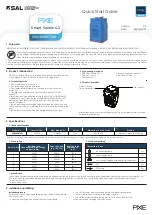
NOTE
The S3700 does not support traffic shaping according to user-defined policy.
2.2 Configuring Traffic Policing Based on an Interface
After traffic policing based on an interface is configured, the S3700 policies the traffic on the
interface.
2.2.1 Establishing the Configuration Task
Before configuring traffic policing based on an interface, familiarize yourself with the applicable
environment, complete the pre-configuration tasks, and obtain the required data. This helps you
complete the configuration task quickly and accurately.
Applicable Environment
If the service traffic sent by users is not limited, a large amount of increasing burst service data
makes a network more congested. To make full use of network resources and provide better
services for more users, you must limit user service traffic. After interface-based traffic policing
is applied to the interface, the rate of all the user service traffic entering the interface is limited.
Pre-configuration Tasks
Before configuring a limit rate on the interface, complete the following tasks:
l
Setting physical parameters of interfaces
l
Setting link layer attributes of interfaces to ensure normal operation of these interfaces
l
Assigning IP addresses to the interfaces and configuring routing protocols to ensure that
routes are reachable
Data Preparation
To configure interface-based traffic policing, you need the following data.
No.
Data
1
CIR and CBS
2
Interface where traffic policing is configured
2.2.2 Limiting the Rate of Traffic on the Interface
To limit the rate of traffic entering the S3700, configure traffic policing on the inbound interface.
Procedure
Step 1
Run:
system-view
S3700HI Ethernet Switches
Configuration Guide - QoS
2 Traffic Policing and Traffic Shaping Configuration
Issue 01 (2012-03-15)
Huawei Proprietary and Confidential
Copyright © Huawei Technologies Co., Ltd.
56
















































